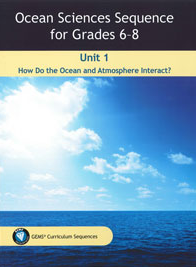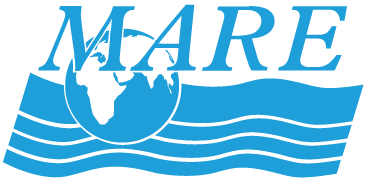OSS 6-8 Unit 1 Resources

Unit 1: How Do the Ocean and Atmosphere Interact?
Session Resources include videos, animations, and simulations that are intended to be used with the curriculum. HTML5 versions of the animations were made possible through funding from the National Marine Sanctuary Foundation, award #16-06-B-00071. Providing More Experience resources are described in the right hand pages of the curriculum and offer excellent supplemental information to support your students’ learning.
Session Resources
Session 1.1: Heat Energy and Moving Molecules
- Simulation: Rising Temperatures (HTML5, new window)
- Simulation: States of Matter
Session 1.2: Water vs. Air
- Simulation: Heat Reservoirs (HTML5, new window)
Session 1.3: The Ocean as a Heat Reservoir
Session 1.4: Temperatures Around the World
- No resources required.
Session 1.5: Mystery of the Floating Balloons
- No resources required.
Session 1.6: Balloon Simulations
- Simulation: Density of Liquids (HTML5, new window)
Session 1.7: Investigating Currents
- No resources required.
Session 1.8: Making Sense of Ocean Currents
- Video: Convection Currents Demonstration
- Animation: The Great Ocean Conveyor Belt
- Animation: Model Ocean Animations (HTML5, new window)
- Providing More Experience video**: Arctic Climate System
Session 1.9: Moving Air
Session 1.10: The Puzzling Case of the Daily Rains
- Providing More Experience video: Earth’s Water Cycle
- Providing More Experience video**: Ocean Temperatures and Climate Patterns
Session 1.11: Global Winds and Ocean Surface Currents
- Animation: Global Winds (under unit 1.10 – See Above)
- Providing More Experience video**: What Causes the Gulf Stream?
- Providing More Experience video animation: Perpetual Ocean
Session 1.12: Ocean Currents, Global Winds, and El Niño
- Providing More Experience video**: Earth System: El Niño
- Providing More Experience video: Super Blooms
Resources marked with a “**” are found on the site PBS LearningMedia, which provides educators with strategies, tools, and professional development resources needed to fully utilize digital learning. These are resources that may be freely accessed through their site, although the site requires that you log in after accessing the site a few times. Logging into the site is free, and allows you to search for a wide variety of educational media.
All other resources, which are listed in the curriculum’s Introduction Book, are also listed at the bottom of this page. We have found these books, DVDs, and websites to be beneficial for additional information on the topics covered in the curriculum.
Books for Students
- Mission: Planet Earth: Our World and Its Climate—and How Humans Are Changing Them
- Authors: Sally Ride and Tam O’Shaughnessy
- Publisher: Flash Point; 1st edition (March 17, 2009)
- Grade Level: 5–8
- Mission: Planet Earth delves into the connection between water, air, and climate and how disrupting one part of the system can cause global change. The book explores the carbon cycle, water cycle, long-range carbon emissions data, biological evidence of climate change, and many other topics relevant to understanding global climate change. It draws from the latest scientific research and is illustrated with helpful diagrams and stunning photographs.
- The Encyclopedia of Weather and Climate Change: A Complete Visual Guide
- Authors: Juliane L. Fry, Hans F. Graf, RIchard Grotjahn, Marilyn Raphael, and Clive Sunders
- Publisher: University of California Press; 1st edition (March 8, 2010)
- Grade Level: 6 and up
- This beautiful and current visual guide contains more than 2,000 color photographs, supplemental maps, and diagrams that help the reader understand many complex phenomenon related to climate change and the interconnection of the ocean and climate. Human survival and adaptations to extreme climates like deserts, jungles, and ice regions are also discussed.
- A Look at Earth (Out of This World)
- Author: John Tabak
- Publisher: Franklin Watts (September 2003)
- Grade Level: 7 and up
- This book provides a good explanation of ocean currents and how the ocean affects the atmosphere as well as other Earth system interactions.
- Hurricanes
- Author: Seymour Simon
- Publisher: Collins (June 26, 2007)
- Grade Level: 4–8
- Beautiful full-color photographs and satellite images help the reader explore hurricanes, typhoons, and cyclones, some of the most devastating events in nature.
- An Ocean of Air: Why the Wind Blows and Other Mysteries of the Atmosphere
- Author: Gabrielle Walker
- Publisher: Mariner Books; Reprint edition (August 4, 2008)
- Grade Level: 8–12
- Gabrielle Walker (author of Snowball Earth) takes an exciting look at tornadoes and hurricanes as well as the captivating history of scientists’ and adventurers’ exploration of these wind-driven storms.
Books for Educators
- The Weather of the Future: Heat Waves, Extreme Storms, and Other Scenes from a Climate-Changed Planet
- Author: Heidi Cullen
- Publisher: Harper; 1 edition (August 3, 2010)
- Leading climatologist and environmental journalist, Dr. Heidi Cullen, shares a current view of climate change and its effects visible in our own backyards as well as not-so-distant-future scenarios for seven of the most at-risk locations on the planet.
- Atmosphere, Ocean and Climate Dynamics: An Introductory Text (International Geophysics)
- Authors: John Marshall and R. Alan Plumb
- Publisher: Academic Press; 1 edition (December 20, 2007)
- By elucidating the topics of radiation, thermodynamics, and fluid dynamics, this book provides a clear and concise introduction to atmosphere, ocean, and climate science.
- The Dance of Air and Sea: How Oceans, Weather, and Life Link Together
- Author: Arnold H. Taylor
- Publisher: Oxford University Press, USA (March 22, 2011)
- Oceanographer Arnold Taylor explores the extraordinary interactions between the atmosphere and ocean and how aquatic and terrestrial ecosystems respond to changes in weather.
- Selected Topics in Environmental Science: Extreme Weather, Atmospheric Chemistry and Pollution, Wetlands and the Carbon Cycle, Cryosphere
- Author: Reynolds, R., Warr, K., Dise, N., and Hodgkins
- Publisher: The Open University; 3.1 edition (April 25, 2009)
- To Follow the Water: Exploring the Ocean to Discover Climate
- Author: Dallas Murphy
- Publisher: Basic Books (2008)
- This book explains such principles as the rise and fall of tides, winds that cause ocean currents, and climate change. Organized around the history of oceanography, beginning with Scandinavian, Portuguese, and Spanish explorers. Describes the gradual discovery of the North Atlantic gyre and how this influenced the history of New World colonization.
DVDs
- Earth: The Operators’ Manual
- Producer: PBS
- In Earth: The Operators’ Manual, join geologist Richard Alley as he travels the world and across the USA, sharing an accurate, understandable and upbeat report on the interlinked stories of humans and fossil fuels, Earth’s climate history and our future energy options. This video can be accessed as a streaming video through PBS.org.
- NOVA/Frontline: Global Warming: What’s Up with the Weather?
- Producer: NOVA and Frontline
- The weather is different now but why? Find out when NOVA and FRONTLINE join forces to determine, What’s Up with the Weather?
- Earth: The Biography – The Story of Our World
- Producer: BBC
- Explore the great forces that shape Earth—volcanoes, the ocean, the atmosphere and ice. How do these forces affect Earth’s landscape, its climate, and its history? Ocean currents are explained in great detail.
Websites for Students
- The Ocean
- National Geographic has created a large, interactive, student-friendly website with many engaging articles and images.
- Global Science Investigator
- An interactive website for students with great visuals using real data.
- The Agulhas Current Time-Series Experiment
- Join an ocean research ship at work as they study the Agulhas current. Great explanations and visuals from physical oceanographers as they study the water, how it moves and why and how its movement affects climate.
- Weather and Climate Activities
- Great interactive site designed for students to explore weather and climate.
Websites for Educators
- Ocean Climate
- This website presents issues related to the ocean and climate, such as : CO2 emissions, polar melt, ocean acidification, and provides a forum for related comments and articles.
- Water Science for Schools
- The U.S. Geological Survey’s Water Science for Schools website offers information on many aspects of water, along with pictures, data, maps, and an interactive center where you can give opinions and test your water knowledge.
- NOAA’s El Niño Page
- This website shows the sea surface temperature in the Equatorial Pacific over the past 6 months. It also has links to forecasts, current research and other El Niño education sites.
- Tracking El Niño, Producer: NOVA Online Adventure (search for El Niño)
- This teacher resource clip provides content that is illustrated and animated in 5 chapters: El Niño’s reach across the globe, El Niño’s ground zero, global weather machine, El Niño’s reach through time and El Niño’s reach into living things. Many other El Niño resources available.
- PBS Learning Media
- A free website for educators, allowing users to access and download resources.

